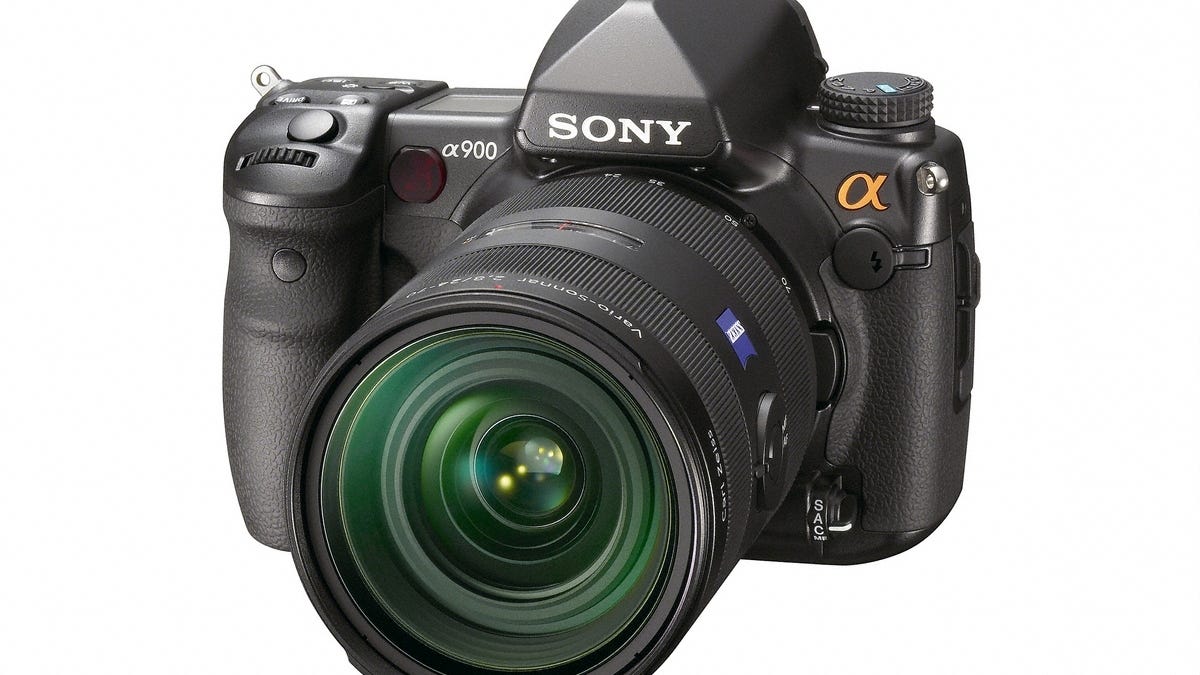Hands-on preview: Sony's full-frame DSLR-A900
At 24 megapixels, this midrange model has the highest resolution to date in a dSLR.

We've seen prototypes under glass and been hearing rumors for months, but Sony's Alpha DSLR-A900 became official September 9 at 9 a.m. ET. The A900's main claim to fame is its 24-megapixel full-frame (the size of a 35mm frame of film) sensor, the highest resolution in a digital SLR to date.
Sony makes a point of not calling this a "professional" camera, instead referring to it as the "flagship" model of its dSLR line. However, it's priced like a pro model, and its competitors--the
First, some comparative highlights:
| Nikon D700 | Sony Alpha DSLR-A900 | Canon EOS 5D | |
| Sensor | 12.1-megapixel CMOS | 24.6-megapixel CMOS | 12.8-megapixel CMOS |
| Sensitivity range (expanded) | ISO 100 - ISO 25,600 | ISO 100 - ISO 6400 | ISO 50 - ISO 3200 |
| LCD | 3-inch/920,000 dots | 3-inch/920,000 dots | 2.5-inch/230,000 dots |
| Continuous shooting frames best quality JPEG/full-size raw | 5 fps/8fps with optional battery grip 100/17 | 5 fps 11/12 | 3fps 60/17 |
| Viewfinder | 95% coverage 0.72x magnification fixed matte focusing screen | 100% coverage 0.74x magnification interchangeable focusing screen | 96% coverage 0.71x magnification interchangeable focusing screen |
| Autofocus | 51-pt AF 15 cross-type f5.6 and wider | 9-pt AF center dual-cross type with 10 assist points; center cross type to f2.8 | 9-pt AF 7 center cross-type f2.8 and wider; single center cross-type f4 and wider |
| Live View | Yes | Yes | No |
| Shutter durability | 150,000 cycles | >100,000 cycles | 100,000 cycles |
| Price (body only) | $2,995 | $2,999.99 | $2,499.99 |
Unlike its competitors, which use lens-based image-stabilization systems, Sony opts for in-body sensor-shift image stabilization, now dubbed "SteadyShot Inside." As with other Sony models, the A900 remains compatible with Konica Minolta lenses. The camera's design is reminiscent of, but not identical to, the A700. It has a small status display on the top that provides some limited information, while the rest appears on the back LCD. Like the A700, the A900 allows you to access and edit all your settings directly via that display, which I happen to like. The controls take a bit of getting used to, since many of them look and feel the same, making it hard to remember their locations. It does provide three custom setting slots on the mode dial, which I really like, and the large, bright viewfinder is a pleasure to use.
One of the A900's distinctive features is Intelligent Preview; hitting the depth-of-field preview button shows a temporary capture of the scene on the LCD, where you can tweak parameters such as exposure, white balance, shutter speed, aperture and so on and get a live-ish preview of the changes. It's quite a neat idea, but in practice I found the LCD didn't represent the image accurately enough to make all but the most basic judgments.
To support the huge bandwidth required by the large images, Sony supplies the A900 with not one but two of its Bionz image processors. That helps the A900 maintain its respectable close-to-5fps burst rate (though even with a UDMA card the buffer fills pretty quickly) and keeps high ISO shots from taking too long to process and save.
A camera in this price range doesn't really need to have great burst performance, but I do expect it to have fast autofocus and single-shot speed. Unfortunately, the A900 doesn't always meet expectations in this respect. For instance, its shot lag under optimal conditions tends to be inconsistent, ranging from as fast as 0.3 second to as high as 0.5 second--the former is quite good, the latter just OK. But my biggest gripe is with the relatively slow autofocus (at least with the 24-70mm f2.8 lens provided by Sony) in dimmer conditions, like indoor lighting. It's slow enough that I missed several shots of active kittens, and tests out at about 1.2 seconds to focus and shoot; that's about the same as a sub-$1,000 dSLR. The Nikon D90 feels more responsive.
I've only shot indoors thus far, but have to admit to some disappointment in what I've seen. (Here are a few sample photos.) Photos aren't as sharp as I'd like, though the high resolution lets you get away with a lack of sharpness, to a certain extent, since you don't have to crop in as far to get the same size print. Photos get noisy and a bit mushy starting at ISO 1600, but standards here depend on how well the competition does, and I haven't seen the test shots for the D700 yet. Color is good, but I've seen surprising posterizing in deep shadows that bears further scrutiny. The bottom line is that when you look at shots from a camera in this class you should have at least a few "wow" moments, and that hasn't happened yet.
Sony expects to ship the camera in November for around $3,000. My final review should be up in the next couple of weeks.

